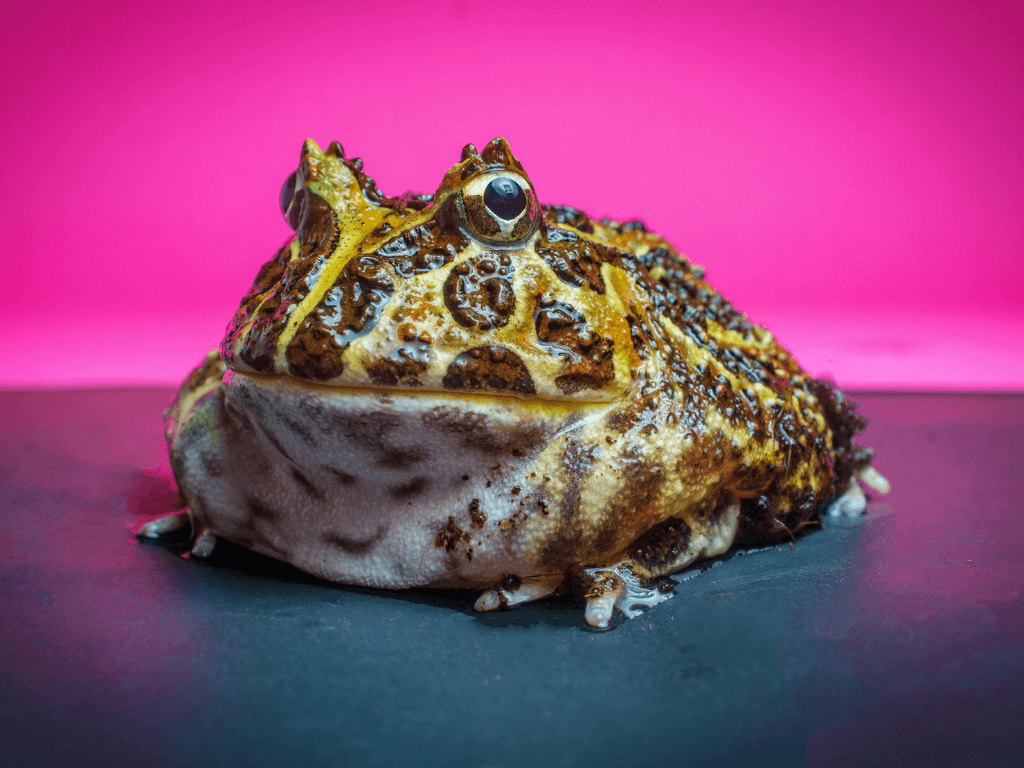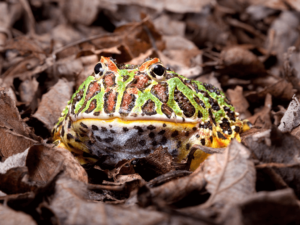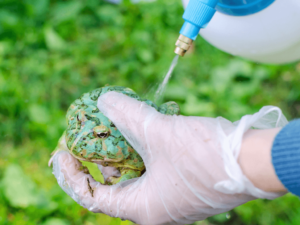Pacman Frog: A Common Name For a Type of Frog

- What is a Pacman Frog?
- Where is the Pacman Frog Native to?
- What is the Scientific Name of the Pacman Frog?
- What are the Physical Characteristics of the Pacman Frog?
- What is the Lifespan of the Pacman Frog?
- What are Some Common Health Issues in the Pacman Frog?
- How Do You Care for a Pacman Frog in Captivity?
- Conclusion
Are you interested in learning more about the Pacman Frog? This unique type of frog is also known as the horned frog or Argentine horned frog. Despite its intimidating appearance, the Pacman Frog is a popular pet due to its easy-to-care-for nature.
In this article, we will explore the physical characteristics, lifespan, common health issues, and care sheet for keeping a Pacman Frog in captivity. Keep reading to become an expert on this fascinating amphibian!
What is a Pacman Frog?
Frog fanatics and amphibian admirers alike may have encountered the Pacman Frog. Also known as a Horned Frog or Argentine Horned Frog, this species is native to South America and is an increasingly popular pet among reptiles and amphibian aficionados.
They boast an impressive figure, with a large, round body that can expand up to the size of a softball. In addition to their impressive size, their voracious appetite is what sets these frogs apart. Pacman Frogs are notorious for devouring just about anything that can fit in their maw, including insects, small rodents, and even other frogs!
The physical features of the Pacman Frog are quite distinct. They have a wide mouth and powerful jaws which aid them in catching their prey. Additionally, a singular horn takes residence atop their head, giving them their nickname of Horned Frog.

These amphibians come in a variety of colors, such as green, brown, and even albino. Interestingly, they possess the ability to change their skin color to blend in with their surroundings, providing them with camouflage from predators.
For those who are considering adopting a Pacman Frog as a pet, there are a few things to keep in mind. These frogs need a warm and humid atmosphere, with lots of hiding spots and a shallow water dish for soaking.
They should be fed a diverse diet of insects, worms, and other small prey, and their enclosure must be cleaned regularly to avoid a buildup of bacteria.
It is also important to watch out for potential health issues in Pacman Frogs such as skin infections and respiratory problems.
With proper care and attention, these frogs can make a delightful and rewarding pet for amphibian lovers.
Where is the Pacman Frog Native to?
Dubbed the Horned Frog or Argentine Horned Frog, the Pacman Frog captivates with its ability to blend into its environment. A survival trait that has allowed it to escape predators, this amphibian is mainly found in South American rainforests, notably in Argentina, Brazil, and Uruguay, where it enjoys a humid habitat such as swamps, ponds, and other watery areas.
Able to tolerate a wide range of temperatures, the Pacman Frog has managed to thrive in the wild.
Nowadays, their popularity as pets has led to many of them being bred in captivity. Therefore, if you decide to get a Pacman Frog as a companion, it's imperative to understand their natural habitat and ensure they have a suitable place to live.
By doing so, you will be able to provide the Pacman Frog with the best possible conditions, allowing them to live happy and healthy life.
What is the Scientific Name of the Pacman Frog?

Ceratophrys Ornata, commonly known as the Pacman Frog, is an amphibian of the family Ceratophryidae. Its moniker is derived from the Greek words keras (horn) and Ophrys (eyebrow), referencing the bony protrusions above the eyes, and Ornata (decorated), referring to the frog's colorful markings.
Identifying this species is vital for understanding its taxonomy and characteristics. It is often called the Horned Frog or Argentine Horned Frog, yet this name is also used for other frogs, such as the African Bullfrog.
By using Ceratophrys Ornata, researchers and scientists are able to ensure accuracy and consistency in communication.
The scientific name of the Pacman Frog reveals much about the animal.
- Keras Ophrys describes the bony protrusions above the eyes
- Ornata refers to its colorful markings
- The taxonomic classification within the family Ceratophryidae is also identified
Learning about Ceratophrys Ornata is a captivating and informative endeavor.
What are the Physical Characteristics of the Pacman Frog?

A characteristic of this species is its enormous mouth, giving it a singular look. This frog also flaunts a rotund body, stubby legs, and sleek, humid skin which may range from green, brown, or even orange.
On the top of its head are two tinny eyes, allowing it to spot potential prey from a high vantage point. The Pacman Frog's vision is not very acute, therefore it mostly relies on its keen sense of smell and movement detection for hunting.
Moreover, its skin is adorned with minute bumps and ridges, helping it camouflage with the environment for predator evasion.
Remarkably, this frog is capable to change its skin pigment to blend in with its surroundings. Additionally, its tongue is equipped with an adhesive quality, which it can shoot out of its mouth at lightning speed to capture prey.
Finally, the Pacman Frog is known for its prodigious appetite. It will eat anything that it can fit into its maw, including insects, small rodents, and even other frogs. To maintain a Pacman Frog's health in captivity, it is essential to supply a balanced diet, including live plants, regular feeding, and cleaning of its abode.
What is the Lifespan of the Pacman Frog?
When considering the commitment of owning a Pacman Frog, its longevity should be taken into account. These amphibians can live up to 15 years in captivity, requiring a significant period of care. To ensure the frog's health and well-being, its diet, housing, and general condition must be monitored and maintained.
It is also important to recognize the American Horned Frog's natural habitat in South America. In the wild, they experience numerous external elements that can affect their lifespan, such as predators, sickness, and other risks. By understanding the environment of the American Horned Frog, owners can better comprehend their needs and provide them with the proper care in captivity.
What are Some Common Health Issues in the Pacman Frog?
Caring for Ceratophrys Cranwelli necessitates vigilance and information, particularly when it comes to spotting usual health problems which may emerge. A frequent health difficulty in Pacman Frogs is the presence of parasites, such as mites and worms, which can cause lethargy, loss of appetite, and even death.
It is critical to periodically inspect your frog for any evidence of parasites and to search for veterinary attention if needed.
Additionally, fungal infections can also materialize, particularly if the frog is kept in a humid environment. Symptoms of a fungal infection encompass discoloration of the skin and sluggishness.
Treating fungal infections requires keeping the atmosphere neat and arid, as well as administering antifungal medication as prescribed by a veterinarian.
Another widespread health difficulty in Ceratophrys Cranwelli has the impact on the bowel, which occurs when the frog ingests an extraneous object or is incapable of digesting its food properly.
This can instigate unease, constipation, and even death if neglected. To avert impacted bowel, it is imperative to guarantee that the frog's diet is composed of suitable-sized prey and to dodge feeding them insects that are too big.
Additionally, supplying a warm and damp environment can aid digestion and hinder constipation.
If you suspect that your Pacman Frog may be enduring from impacted bowel, solicit veterinary attention instantly, as this issue necessitates prompt treatment to dodge serious implications.
How Do You Care for a Pacman Frog in Captivity?

Caring for your Cranwell Horned Frog calls for creating a terrarium that mirrors its natural habitat. A spacious abode with a moist substrate for burrowing is essential, along with temperatures ranging from 75-85°F during the day and cooler at night.
A UVB bulb should be installed for lighting. To keep the living space clean, be sure to discard uneaten food and waste regularly, and mist the substrate to maintain moisture.
Equally important is providing a nutritious diet. In the wild, Pacman Frogs are omnivores and will consume a variety of insects, small rodents, and other frogs.
In captivity, you can offer a mixture of crickets, mealworms, waxworms, and other insects, plus some frozen-thawed pinkie mice to supplement their nutrition.
Take care not to overfeed and monitor their weight for optimal health.
Conclusion
In conclusion, the Pacman Frog is a fascinating creature that is known for its distinctive appearance.
It is a popular pet among amphibian enthusiasts due to its unique features and easy care requirements. Although the Pacman Frog may appear intimidating with its green and brown coloration, it is actually a docile animal that can make a great addition to any household.
By following the proper care guidelines and providing suitable habitats, you can ensure that your Pacman Frog lives a long and healthy life.
Whether you are a first-time reptile owner or an experienced amphibian enthusiast, the Pacman Frog is definitely worth considering for your next pet.

Leave a Reply